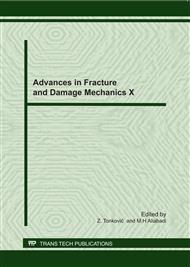p.105
p.109
p.113
p.117
p.122
p.126
p.130
p.134
p.138
Performance of Different Metal-Foam Stuffed Whipple Shield against Hypervelocity Impact of Space Debris
Abstract:
Hypervelocity impacts on spacecraft in low earth orbit by meteoroids and space debris poses a threat to space missions, and the use of a shield can significantly decrease the probability of a catastrophic failure. Tests have identified that metallic foams have a good shielding performance against hypervelocity impact by micro-meteoroids and orbital debris. A metal-foam stuffed Whipple shield was presented under the concept of light-weight shield structure. A meso-structure model of geometry for metallic foams was set up simulating their manufacturing process and validated by comparison with experimental results using own SPH code. Three base materials of foam, including Al 7075-T651, Ti and Al ZL102, were researched for their performances as stuff of shield by means of numerical simulation. The results indicated that different base materials show the best shield performance at different impact speeds with other conditions the same. The foam of Al ZL102 stuffed can cause the strongest radial dispersion of the secondary debris cloud and is more likely to provide the best shield performance, which is proved at the higher part of the speed range investigated.
Info:
Periodical:
Pages:
122-125
Citation:
Online since:
September 2011
Authors:
Keywords:
Price:
Сopyright:
© 2012 Trans Tech Publications Ltd. All Rights Reserved
Share:
Citation:


